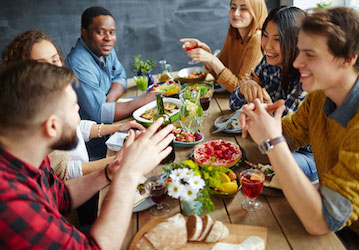Dining with others is a good chance to build social ties, but it also might impact your eating habits for better or worse. For many, meal sharing most commonly occurs with family members. And there are several benefits to making family mealtime a priority. For example, kids who eat with their families are more likely to consume healthier foods, drink less soda, and take in more vitamins and fiber.
Those healthy habits tend to stay with them after they leave home too. But beyond what you eat, sharing mealtimes together gives you a chance to tune into your family members, catch up on the day, and talk about what matters. Make it a point to sit down for family meals as much as your schedule allows. You can also involve your loved ones in planning, grocery shopping, and cooking meals to optimize your nutrition and family time.
Nutrition and physical fitness
Shared meals aren’t just about building bonds and healthy habits with your family. Eating meals with others is associated with better nutrition habits in adults too. Communal meals with friends, colleagues, or battle buddies can be a chance to improve your social fitness as well. When you’re in the field, in theater, or even just in training, you might find yourself sharing your breakfast, lunch, and dinner with your teammates. Just like with your family, it can be a good opportunity to bond, understand each other’s values, and build a shared culture. At work, try to step away from your desk, grab your colleagues, and sit down for lunch. At home, invite friends to bring their favorite dish for a potluck, challenge them to a friendly cooking competition, or share cooking duties and enjoy the delicious results by sitting down to eat together.
Just as eating meals with others can affect your habits, so can working out with a group. Group exercise can help build camaraderie within your family and unit, and it also helps keep you accountable to your goals. Try to schedule a group meal before a competition or enjoy a post-workout recovery meal together to build on those healthy habits. Your social circle influences what and how much you eat—and how often and hard you work out—so surround yourself with people who support your health and fitness goals.
Social and mental fitness
Your social environment also can have a major impact on your food choices. Whether they’re aware of it or not, people look to others to understand how to act. So, when it comes to eating, many tend to follow what those around them are doing. That means if those around you have healthy habits, you’ll likely start to pick them up too. On the flip side, if you have specific dietary goals, you’ll need to be extra aware when eating with others who might not be on the same path.
Community mealtime helps you take a break from the everyday hassles of life to enjoy your food and the company of others, which can strengthen your mental performance and health as well. Experiencing a healthy diet of positive emotions helps to enhance your mental resilience, improve creativity, and buffer against stress, anger, and other negative feelings. You can keep the good vibes going during mealtime by discussing what you’re grateful for that day or things you’re excited about. Or just share in others' joy. Taking the time to focus on the good with one another will increase everyone's personal resilience, as well as trust and cohesion within your group. It’s easy to rush through meals or even multitask while you’re eating as deadlines build. Still, you can boost your productivity by taking some time to slow down, practice mindful eating, and being fully present while enjoying food with others.
